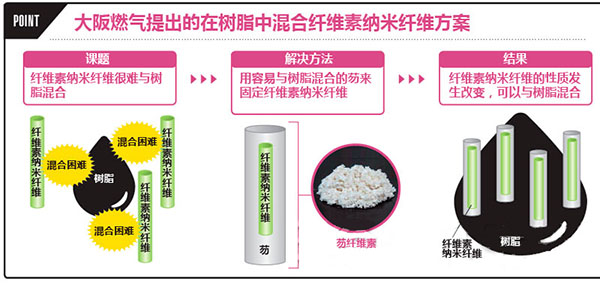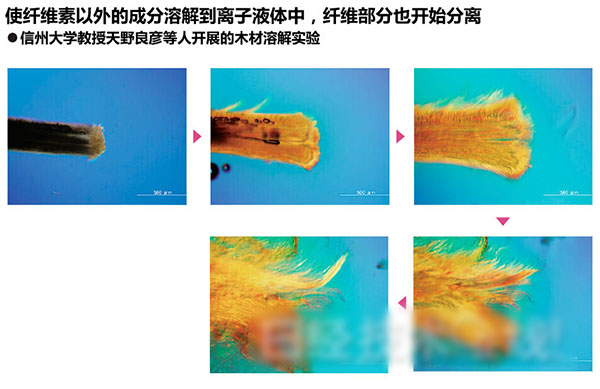At present, the development of new materials "cellulose nanofibers" based on plants has progressed significantly. This material is both strong and lightweight, and is expected to replace metals and plastics in the future. With the successful development of trial products that solve technical difficulties, the practicalization process has been further accelerated. As a new material promising to replace widely used metals and plastics, cellulose nanofibers (CNF) are currently the focus of material science. CNF is a fiber with a diameter of only 3 to 4 nanometers (nanometers to 1 billionth of a nanometer) made by decomposing papermaking raw materials—pulp (vegetable fiber). The strength is more than 5 times that of iron The reason why CNF has attracted attention is because CNF has the specialty: It weighs only one-fifth of iron and its strength is more than five times that of iron. The fibers are wound together to achieve extremely high strength. Moreover, the raw materials of pulp - trees, straws can be planted. Therefore, unlike non-renewable oil and other raw materials, there is little chance of depletion in the future. This is also a major feature of CNF. The main forces for the research and development of CNF are Japanese paper making using pulp in daily operations, papermaking companies such as Prince Holding (HD), and the University of Tokyo. Japan’s national level support has also been fully implemented. The Ministry of Environment has applied for JPY 3.8 billion as an application for the promotion of CNF’s operating expenses in its 2016 budget estimate application. The Japanese Ministry of Economy, Trade and Industry also believes that by 2030, the CNF-related market will reach 1 trillion yen. As a substitute for other fiber reinforcement materials At present, CNF is most favored for its use as a reinforcing material for synthetic resins such as plastics and rubber used in residential building materials, automotive interior materials, and tires. By mixing CNF in plastic and rubber, strength is increased and weight is reduced. Compared with carbon fiber and glass fiber, which are now used as reinforcing materials, CNF has the advantage of being transparent. In the waste incineration, it does not leave residues like glass fiber. On the other hand, there are still some issues for practical application and popularization. The first is the price. The current manufacturing cost of CNF is from 1 kg to tens of thousands of yen. The price is more expensive than 1kg for carbon fiber of 3,000 yen and glass fiber of 2,000 yen. The second is that CNF is difficult to mix with the resin. However, significant progress has been made in the resolution of this topic. In September 2014, Osaka Gas successfully developed a CNF that was easy to mix with resin, and attracted the attention of those involved in CNF research and development. Developers of Osaka Gas have noticed that the organic compound “芴†used for the lens of smartphones and digital cameras has the property of being easily mixed with the resin. So think of coating the crucible on the surface of the CNF. The type of hydrazine used was repeatedly changed, and the temperature at the time of coating was tested to develop a CNF that can be uniformly distributed in the resin. Osaka Gas has named it "Silk cellulose." Of course, there are still some types of resins that are difficult to mix and there is still a lot of room for R&D. For another issue - reducing manufacturing costs, Yukio Yumura, manager of the Osaka Gas Energy Technology Research Institute, said in an upbeat manner: "We will definitely reduce manufacturing costs to carbon fiber." In the field of diapers and stationery products have been realized Prior to resin-reinforced materials, CNF has already been commercialized in certain applications. One of them is Nippon Paper's subsidiary, the Japanese papermaker Crecia who manufactures and sells toilet paper and tissue products, and the adult skin diaper “Skin Care ACTY†series that was launched on October 1st. Silver ions and gold ions have a deodorizing effect and are commonly used in air fresheners and fragrances. The company noticed that although these two ions do not adhere to paper, they can adsorb on fine CNF. A CNF layer that adsorbs silver ions and gold ions is locally used in diapers. "The diameter of the CNF is only nanometers, but its surface area is large, and it can absorb a lot of odors, and the deodorizing effect is 3 times that of the conventional products," said Kawasaki Hayashi, head of the CNF business promotion department of the CNF cooperative. In terms of price, the underwear-type 1 pack of 22 tablets is approximately 1,680 yen (excluding tax), and the price is higher than that of the previous products of the series, and the positioning is a high-end product. In the future, the company will continue to expand the scope of application of the CNF layer. The chemical industry's No. 1 Industrial Pharmaceuticals hopes to use the other properties of CNF to make it widely used in various products. CNF is sticky after being dissolved in a liquid such as water, and its state is similar to jelly. In this state of pressurization, the jelly will become a liquid, and after decompression, it will return to a jelly-like state and will not easily fall. Using this property, the company has developed a thickening agent "RHEOCRYSTA" containing CNF. Mitsubishi Pencil's ball-point pen “Uni-ball Signo UMN-307†sold in Europe and the United States makes this thickener practical. This type of ballpoint pen incorporates RHEOCRYSTA in the ink, which is not easy to drop ink, and it is not easy to break the text when writing with force, and it is not easy to make the ink fade after writing. The director of the First Industrial Pharmaceutical Functional Chemicals Division, Tomoko Touji, said confidently: “Although the pricing is several times that of existing thickeners, the market has a need for new added value such as continuous lines and intractable ink. In the future, Uses will gradually expand into toilet fragrances, sprays, coatings, and inks." The development of manufacturing methods also set off a boom On the other hand, with the university as the center, the development of the CNF mass production method has also given rise to an upsurge. For example, the research group of Professor Isobeimaki and others of the University of Tokyo established a production method using a catalyst. In the past, a physical method of grinding pulp was generally used to manufacture CNF, and the fineness of the particles was difficult to reach several nanometers. Prof. Isabella and others produced CNF through chemical treatment and developed a special catalyst named “TEMPO Catalystâ€. With this type of catalyst, the pulp strands are charged under the action of negative electrons because the homogeneity repels and spreads out to produce the CNF. This method has been adopted by the aforementioned CNF produced by Japan Paper and the First Industrial Pharmaceuticals. Prince HD took another path and developed another chemical method. On September 28, it announced the development of a CNF that can supply powder. Because it can be supplied in the form of a powder, the burden of storage and transportation is greatly reduced compared to a jelly-like CNF containing a large amount of moisture. "In the production of common thickeners and other products, it is often accompanied by the step of mixing powders. It is also significant that CNF can be used without changing the current production method." A team of professors from Shinshu University, Shinya Azino and Tottori University Itomitsu, and others, developed a manufacturing method using amino acid ionic liquids in order to dissolve wood and extract cellulose (carbohydrates). Professor Amano said: “In the past, it was necessary to use harmful pharmaceutical agents. It is now possible to use relatively safe ionic liquids for dissolution.†During this process, unexpected discoveries have also emerged: When Deer grass is dissolved in an ionic liquid, observation of the plants that begin to dissolve using a microscope reveals that its tip has become rough and has been divided into strips of fibers. The mechanism of fiber separation is not yet known, but Professor Amano said: "This may help establish a new method for extracting CNF from plants." In September 2015, Professor Gengbei of East University became the first in Asia to win the Marcus Wallenberg Prize for "Nobel Prize in the field of forest timber science," with the development of the TEMPO catalyst. Prize). As Japan's domestic companies and universities unleash the development of manufacturing methods, manufacturing costs have been drastically reduced, and various types of products using CNF as materials have emerged in an endless stream. If such a virtuous circle can be formed, it may be possible to open up an opportunity for Japan to master CNF in the future. The manufacturing method and the global leading position of the product. (Reporter: Matsuura Longfu, Nikkei Business Weekly) Plasterboard Screws,Sheetrock Screws,Gypsum Board Screw,Plasterboard Anchor Fixings NINGBO YWC IMP. & EXP. CO.,LTD , https://www.nbywc-fastener.com
